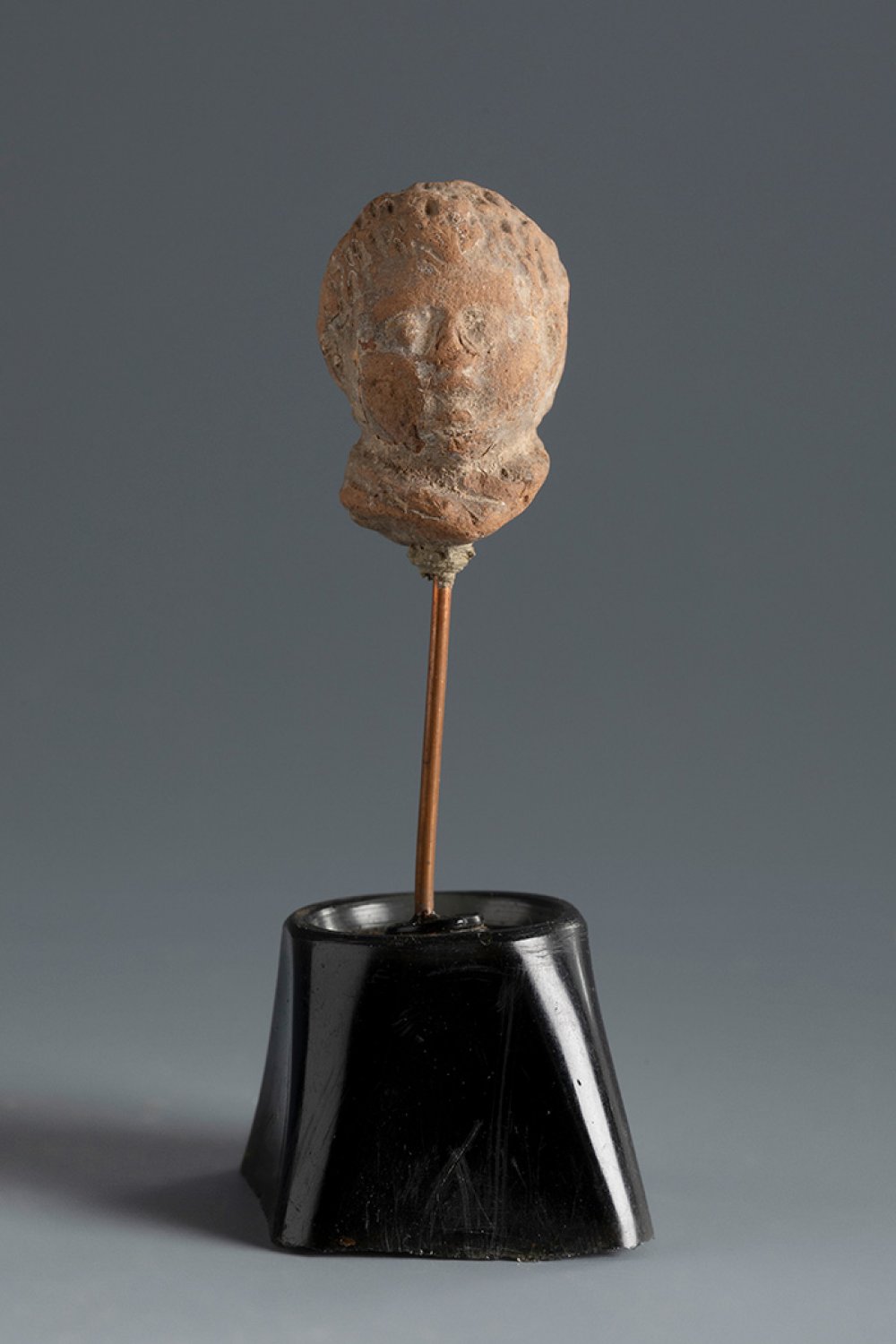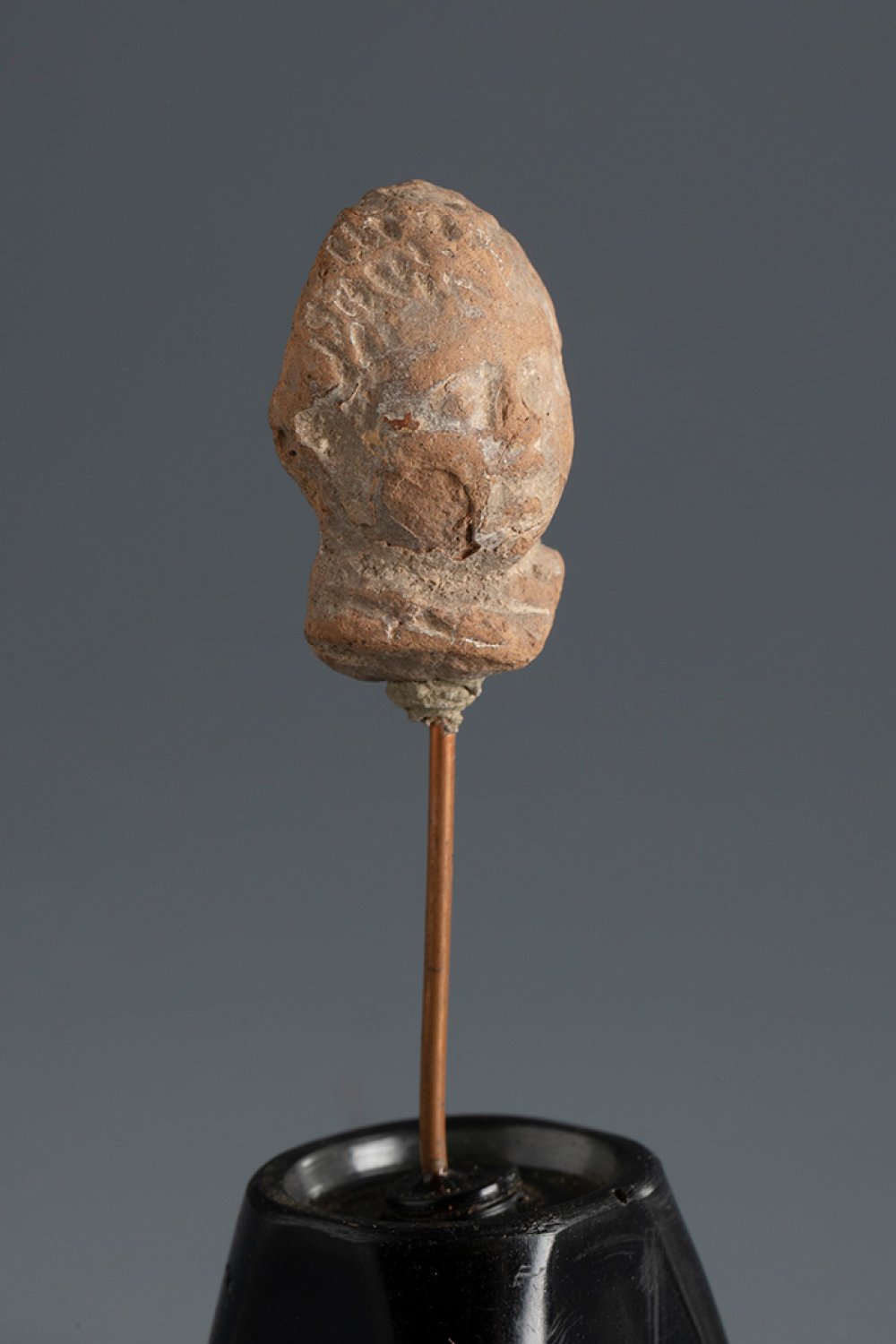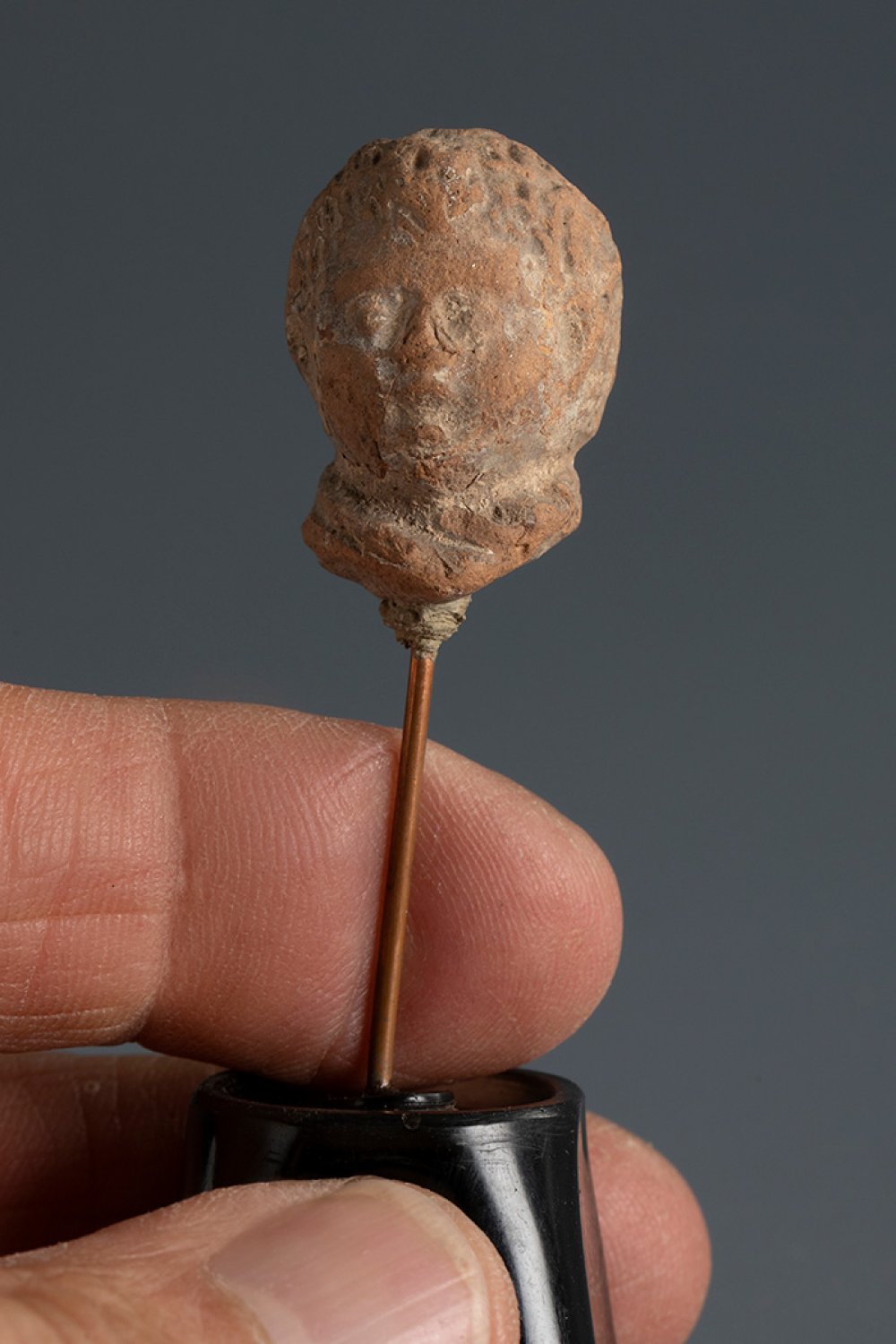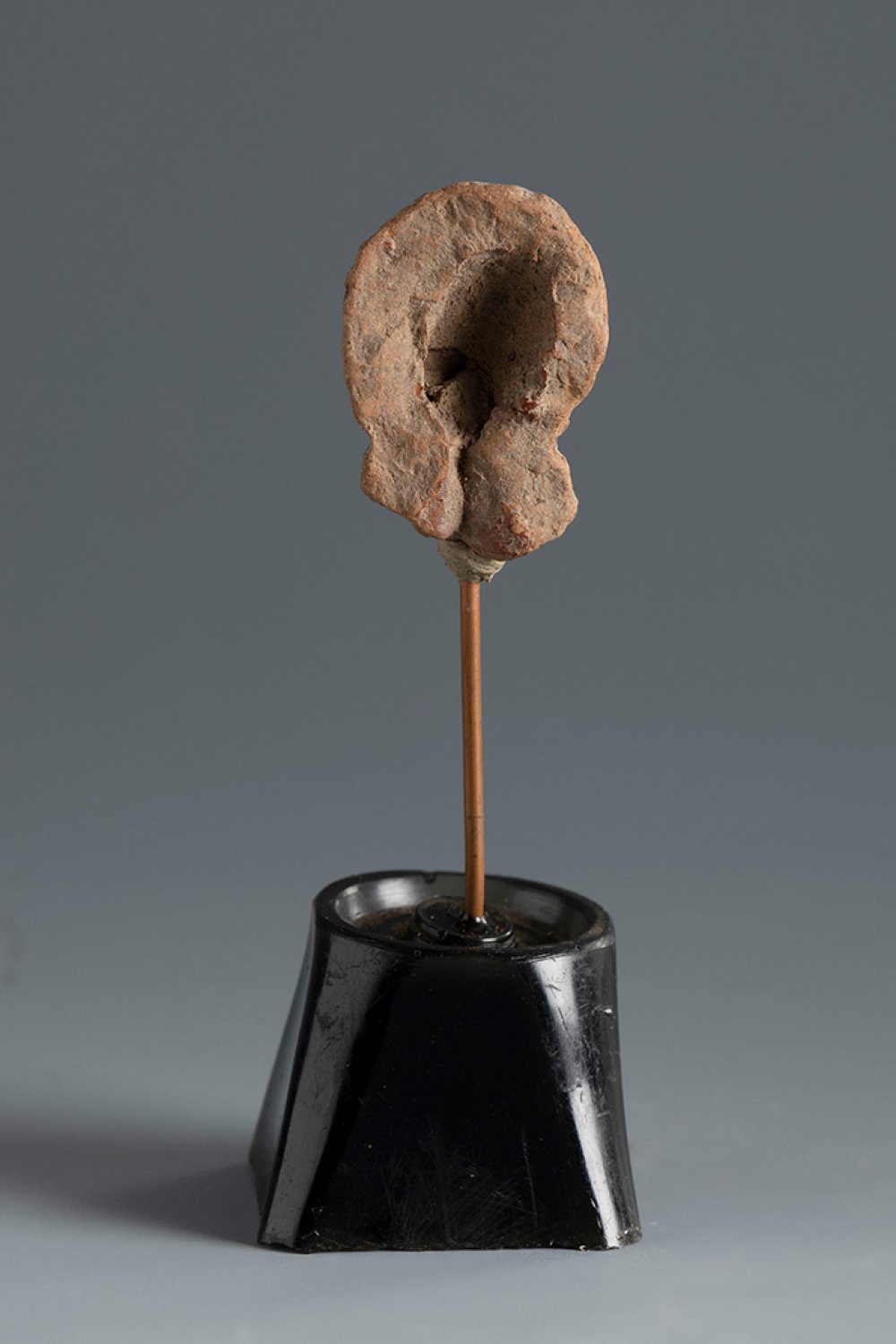50
Child's head. Smyrna, 4th-3rd century BC.Terracotta.Provenance: Smyrna, 1895-1905. Collection Paul
Terracotta.
Provenance: Smyrna, 1895-1905. Collection Paul Gaudin (Paris 1858-1921 Versailles), archaeologist, engineer and great patron of the Louvre Museum; Acquired between 1894 and 1905 and by family descent. Public auction, France, 2022.
Measurements: 7.6 cm. high with stand.
Terracotta head of a child. This piece is part of an archaeological collection of 670 fragments, considered to be the second largest after the Louvre (1094 fragments) and ahead of those of the Archaeological Museum of Istanbul (135) and the British Museum (108). According to Simone Besques (1972, p.155) "There are hardly any public or private collections that do not contain Smyrna figurines, most of which are unfortunately fragmentary. Nevertheless, they testify to the fact that from the 3rd century BC to the 2nd century AD, the most important Hellenistic and Greco-Roman workshops were located there, both in terms of the quality and originality of their production, and the fact that these figures remained intact until the Roman period".
Smyrna was one of the original terracotta centres of Asia Minor. The city was refounded by Lysimachus around 288 BC, a short distance from its former location. Continued habitation until more recent times made systematic excavations impossible. Most of the Smyrna figurines on display in major museums in Europe and the United States are mostly fragments of heads. Smyrna figurines are easily recognised by the colour of their clay, which varies from brown to red. The clay is fine and homogeneous, and contains traces of gold and silver. Some samples still retain their colours. They are carefully modelled.
In terms of subject matter, many popular types from the great terracotta art of the Classical or Hellenistic period prevail, such as those of Herakles, deities and athletes. Another favourite subject was clothed female figures of the "Tanagrian" type.
There are also so-called "grotesque figures" with exaggerated anatomical deformities. They probably represented real people suffering from deforming diseases.
The terracotta style of Smyrna shows great similarities with that of Myrina. It is likely that the same terracotta artists worked in both cities. It is more likely that there was a relevant relationship in Pergamon and Cyme. On the other hand, certain thematic types of the Smyrna workshop - the black figures and the grotesques - allude to the terracotta art of Alexandria, which ensures a close commercial and artistic relationship with that city. Figurines from Smyrna were highly prized in the ancient world. They were exported to Myrina, Priene, Pergamon, Troy, Tarsus, Delos, Athens, Cyprus and Black Sea cities.
Terracotta.
Provenance: Smyrna, 1895-1905. Collection Paul Gaudin (Paris 1858-1921 Versailles), archaeologist, engineer and great patron of the Louvre Museum; Acquired between 1894 and 1905 and by family descent. Public auction, France, 2022.
Measurements: 7.6 cm. high with stand.
Terracotta head of a child. This piece is part of an archaeological collection of 670 fragments, considered to be the second largest after the Louvre (1094 fragments) and ahead of those of the Archaeological Museum of Istanbul (135) and the British Museum (108). According to Simone Besques (1972, p.155) "There are hardly any public or private collections that do not contain Smyrna figurines, most of which are unfortunately fragmentary. Nevertheless, they testify to the fact that from the 3rd century BC to the 2nd century AD, the most important Hellenistic and Greco-Roman workshops were located there, both in terms of the quality and originality of their production, and the fact that these figures remained intact until the Roman period".
Smyrna was one of the original terracotta centres of Asia Minor. The city was refounded by Lysimachus around 288 BC, a short distance from its former location. Continued habitation until more recent times made systematic excavations impossible. Most of the Smyrna figurines on display in major museums in Europe and the United States are mostly fragments of heads. Smyrna figurines are easily recognised by the colour of their clay, which varies from brown to red. The clay is fine and homogeneous, and contains traces of gold and silver. Some samples still retain their colours. They are carefully modelled.
In terms of subject matter, many popular types from the great terracotta art of the Classical or Hellenistic period prevail, such as those of Herakles, deities and athletes. Another favourite subject was clothed female figures of the "Tanagrian" type.
There are also so-called "grotesque figures" with exaggerated anatomical deformities. They probably represented real people suffering from deforming diseases.
The terracotta style of Smyrna shows great similarities with that of Myrina. It is likely that the same terracotta artists worked in both cities. It is more likely that there was a relevant relationship in Pergamon and Cyme. On the other hand, certain thematic types of the Smyrna workshop - the black figures and the grotesques - allude to the terracotta art of Alexandria, which ensures a close commercial and artistic relationship with that city. Figurines from Smyrna were highly prized in the ancient world. They were exported to Myrina, Priene, Pergamon, Troy, Tarsus, Delos, Athens, Cyprus and Black Sea cities.
10th November - Ancient Art
Sale Date(s)
Venue Address
General delivery information available from the auctioneer
Setdart offers Worldwide shipping
PICK UP IN ROOM: You can come and pick up your lots in our offices (Barcelona, Madrid or Valencia). At the moment of the withdrawal, you will be able to accept the current conditions of the lot by means of a document that you will sign.
YOU CAN SEND ANOTHER PERSON TO PICK UP: This person must present a signed authorization that you can find in our web page by accessing from BUY AT SETDART- LOGISTICS-DOWNLOAD AUTHORIZATION DOCUMENT. You can also send an e-mail with the requested data in AUTHORIZATION DOCUMENT to admin@setdart.com
Important Information
25% buyer´s premium
Terms & Conditions
The maximum period to pay the lots is 7 working days. You can pay either via bank transfer or with credit card through our platform www.setdart.com (we only accept VISA or Mastercard).
BUYER´S PREMIUM: 22% Hammer price + 21% VAT from the buyer´s premium
If your piece has more than 100 years, our Ministry of Culture requires an export certificate in order for the piece to leave the country. Note that if the piece goes inside the EU, there is no cost for the export certificate. If the piece goes outside the EU, there is a cost for the export certificate. You can find more information in our Ministry of Culture website: https://www.culturaydeporte.gob.es/en/cultura/patrimonio/exportacionimportacion/exportacion/tasas.html
INQUIRIES: admin@setdart.com
Setdart guides you through the entire process, from the time of award to the day you receive your lot. Our logistics team will be happy to manage your transport, and will advise you on the best shipping method with professionals from the sector used to handling works of art and jewelry.
WE OFFER WORLDWIDE DOOR TO DOOR SHIPPING
PICK UP IN ROOM: You can come and pick up your lots in our offices. At the moment of the withdrawal, you will be able to accept the current conditions of the lot by means of a document that you will sign.
YOU CAN SEND ANOTHER PERSON TO PICK UP: This person must present a signed authorization that you can find in our web page by accessing from BUY AT SETDART-LOGISTICS-DOWNLOAD AUTHORIZATION DOCUMENT. You can also send an e-mail with the requested data in AUTHORIZATION DOCUMENT to admin@setdart.com
SETDART IS NOT RESPONSIBLE FOR THE STATE OF THE PARTS ONCE THEY LEAVE OUR FACILITIES. MRW SHIPMENTS: Once the payment is made, your lot will be packed for shipment, the logistics department will send you an e-mail notifying you of the day it leaves our warehouse, changes of address cannot be made after receiving this e-mail.
INSURANCE INCIDENTS: Coverage for the value of the auction up to 3000 ? per shipment, if the value of the auction is higher, Setdart will send you a quote including the additional insurance. The insurance company WILL NOT BE RESPONSIBLE FOR THE SHIPMENT THAT EXCEEDS THAT AMOUNT AND IS NOT FULLY INSURED. MRW INCIDENTS: Maximum notification 48 hours after receipt, after which the insurance company WILL NOT BE RESPONSIBLE AND NO CLAIMS WILL BE ACCEPTED.
E-MAIL LOGISTICS: logistica@setdart.com
PICK UP YOUR MESSAGES: You can send your own messaging, prior notice via e-mail that your shipment is ready, please note 3 or 4 days in advance. This type of shipment is packaged so Setdart will provide you with a quote.
EXPENSES FOR STORAGE: We inform you that if the purchased lot is not picked up within a month, you will be charged 30€ per week per lot. Setdart Online S.L., owner of the web site "setdart.com", "setdart.net" and "setdart.org", acts as a company of Spanish nationality inscribed in the Volume 36955, sheet 182, page B-293056 of the Mercantile Registry, with registered office at Calle Aragó












